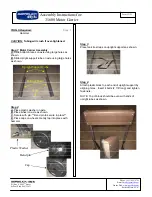
EVAL AD5933-U1
Preliminary Technical Data
Rev. PrA | Page 4 of 16
LK4
The analog circuitry section of the AD5933 is powered through Terminal Block J10-1 (AVDD-SIG). This terminal block is
supplied with an external voltage source. The user can use the on board high performance voltage regulator, AD3303, to act
as the voltage supply to the AVDD_SIG pin of the AD5933.
When this link is inserted, the output of the ADP3303 3.3 V regulator (U4) is connected to the analog voltage supply pin of the
AD5933 (Pin 10).
When this link is removed, the output of the ADP3303 3.3 V regulator (U4) is disconnected from the analog voltage supply pin
of the AD5933 (Pin 10). In this case, the AVDD-SIG pin has to have an external supply voltage supplied applied via J10-1.
LK5
The analog circuitry section of the AD5933 is powered through Terminal Block J10-1 (AVDD-SIG). This terminal block is
supplied with an external voltage source. The user has the facility of using the on board high performance voltage regulator
AD3303 to act as the voltage supply to the AVDD_SIG pin of the AD5933.
When this link is inserted, the output of the ADP3303 3.3 V regulator (U4) is connected to the analog voltage supply pin of the
AD5933 (Pin 10).
When this link is removed, the output of the ADP3303 3.3 V regulator (U4) is disconnected to the analog voltage supply pin of
the AD5933 (Pin 10). In this case, the AVDD-SIG pin has to have a external supply voltage supplied applied via J10-1.
LK6
This link is used in conjunction with Link 1 and Link 2. The output excitation voltage can be directly applied to the TF1-OUT
SMB connector by inserting Link 6 and removing both Link 1 and Link 2.This output excitation voltage may be post amplified
by routing the signal through a noninverting amplifier by removing Link 6 and inserting Link 1 and Link 2.
When this link is inserted, the output of the AD5933 is connected directly to the input of the TF1_OUT SMB connector.
When this link is removed, the output the AD5933 is not connected directly to the input of the TF1_OUT SMB connector.
When this link is removed, Link 1 and Link 2 must be inserted. This is assuming that the user has inserted an operational
amplifier.
LK7
This link is inserted to connect the Tf2-OUT SMB connector to the inverting terminal of the transimpedance amplifier within
the AD5933. This link is required to complete the signal path and should be inserted while running a sweep.
When Link 7 is inserted, TF2-OUT is connected to the inverting terminal of the transimpedance amplifier in the AD5933.
When Link 7 is removed, TF2-OUT is connected to the inverting terminal of the transimpedance amplifier in the AD5933.
LK8
This is an applications sweep test link. When this link is inserted, one end of a 15 pF capacitor is connected across the tf2 pin of
the AD5933. This link should be removed when running a normal sweep across TF1-OUT/TF2-OUT SMB connectors.
LK9
This is an applications sweep test link. When this link is inserted, one end of a 15 pF capacitor is connected across the tf1 pin of
the AD5933. This link should be removed when running a normal sweep across TF1-OUT/TF2-OUT SMB connectors.
SMB JUMPER FUNCTIONS
Table 3.
SMB Function
CLK1
The user can apply an external 16 MHz clock signal to the AD5933 Pin 8. Link 3 is inserted and the external clock signal is
applied to this SMB connector. Alternatively, Link 3 can be removed and either the on board high performance 16 MHz
surface-mount crystal or the internal RC oscillator can be used to clock the system.
CLK2
This link is for test purposes only. It provides a direct link to the output of the internal direct digital synthesizer, which
generates the initial external excitation signal. This signal is subsequently signal conditioned before being output on Pin 6. In
test mode, the DDS output is available externally on the CLK2 SMB connector. This signal path is not connected to the DDS
output in normal standby mode.
TF1_OUT
The signal available on this connector, which is to be connected to some unknown impedance whose value is to be
determined, is either the direct excitation voltage output from Pin 6 from the AD5933 or an amplified version, depending on
the status of Links 1, 2, and 6.
TF2_OUT
This connector takes the response signal from across the unknown impedance and provides a path back to the input pin (tf2,
Pin 5). Link 7 must be inserted for the path to be complete. The external feedback resistor has one point connected to this
signal path as shown the board schematic (Figure 24).


































